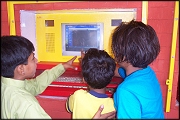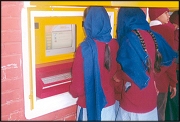
|

|
|||||||||||||||||||||||||
|
||||||||||||||||||||||||||
|
Minimally Invasive Education
The central idea behind Hole-in-the-Wall is that groups of children learn on their own without any direct intervention. This was conceptually explained by Dr Sugata Mitra, Chief Scientist of NIIT, as Minimally Invasive Education (MIE). He found that children using Learning Stations required little or no inputs from teachers and learnt on their own by the process of exploration, discovery and peer coaching. The idea of MIE has crystallized over a period of time based on observations and educational experiments conducted at NIIT.
MIE uses children's natural curiosity and focuses on providing an enabling environment where they can learn on their own. Children, in the process of freely experimenting with the Learning Station, pick up critical problem solving skills. It also provides a collaborative setting where children can share their knowledge and in the process, develop better group dynamics, all in a highly natural environment. MIE's uniqueness is its ability to attract children towards the Learning Station driven purely by their own interests. Conventional pedagogy, on the other hand, focuses on the teacher's ability to disseminate information in a classroom setting. MIE thus complements the formal schooling system by providing a much needed balance for a child to learn on her own and provides for a holistic learning experience. |
|
|||||||||||||||||||||||||
|
© Hole-in-the-Wall Education Ltd. 2015 | Privacy Policy | Terms of Use |
||||||||||||||||||||||||||


